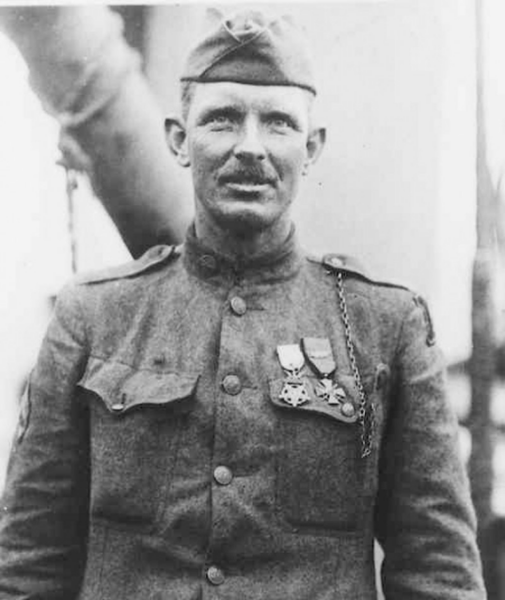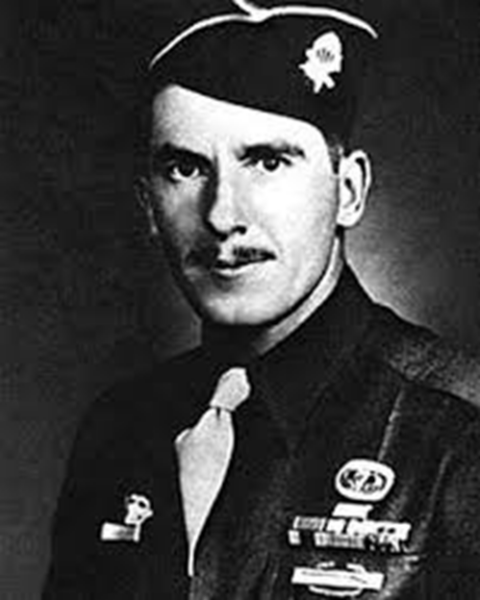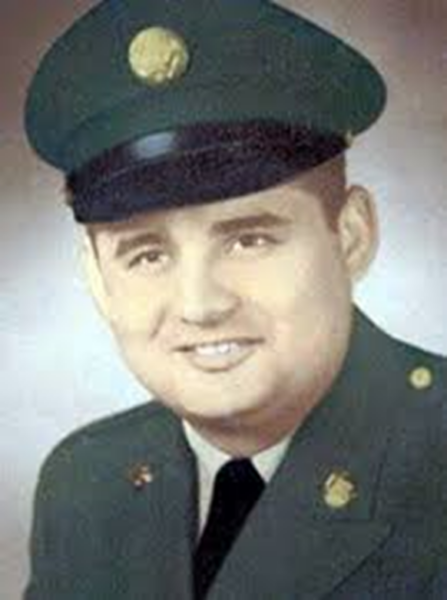Medal of Honor
Read stories of the All-American Soldiers awarded the Congressional Medal of Honor for gallantry in combat from WWI, WWII, and Vietnam

CORPORAL, ALVIN C. YORK
- Born. December 13, 1987
- Died. September 2, 1964, Nashville, TN
- Burial. Wood River Cemetery, Pall Mall, TN
- Unit. G Company 2-328th Infantry
On 8 October 1918, Corporal York was the point man in a 17-man patrol that ventured into enemy territory in attempt to silence machine gunners. Mimicking the Tennessee woodsman’s silent passage into the forest, the Americans advanced four hundred yards without drawing gunfire. Suddenly, they saw two German soldiers and gave chase. Soon, they stumbled on a behind-the-line German command post. The startled Germans dropped their weapons. Using his German captive as a shield, York killed eighteen machine gunners as they popped their heads up to get a clear view of him. But, just as the machine gun fire began to stop, six German soldiers and an officer rushed York. He killed them with his pistol. Holding a pistol to the German major’s head, York made the Germans carry the All-Americans wounded. He led his 132 captives back to American lines.

LIEUTENANT COLONEL, EMORY J. PIKE
- Born. December 17, 1876
- Died. September 16, 1918, France
- Burial. Woodland Cemetery, Des Moines, IA
- Unit. 82d Division
82d Division Lieutenant Colonel Emory J. Pike earned the Division’s first Medal of Honor in the St. Mihiel Offensive. During the 328th Infantry’s taking of Vandières, divisional machine gun officer Pike was on frontline reconnaissance. When enemy shellfire disorganized advancing infantry soldiers, he reorganized the men―at significant risk to himself―and secured their position. He was not finished. Dashing to the aid of a wounded infantry soldier at an outpost, a German shell struck Pike he suffered fatal injuries.

PRIVATE FIRST CLASS, CHARLES N. DEGLOPPER
- Born. November 30, 1921
- Died. June 9, 1944, Manche, Normandy, France
- Burial. Maple Grove Cemetery, Grand Island, New York
- Unit. C Company 1-325th Glider Infantry Regiment
The Medal of Honor is presented to Charles N. DeGlopper, Private First Class, U.S. Army, for conspicuous gallantry and intrepidity in action beyond the call of duty. Private First Class DeGlopper was a member of Company C, 325th Glider Infantry Regiment, 82d Airborne Division, on 9 June 1944 advancing with the forward platoon to secure a bridgehead across the Merderet River at La Fiere, France. At dawn, the platoon had penetrated an outer line of machineguns and soldiers, but in so doing had become cut off from the rest of the company. Vastly superior forces began a decimation of the stricken unit and put in motion a flanking maneuver which would have completely exposed the American platoon in a shallow roadside ditch where it had taken cover. Detecting this danger, Private First Class DeGlopper volunteered to support his comrades by fire from his automatic rifle while they tried a withdrawal through a break in a hedgerow forty yards to the rear. Scorning a concentration of enemy automatic weapons and rifle fire, he walked from the ditch onto the road in full view of the Germans and sprayed the hostile positions with assault fire. He was wounded, but he continued firing. Struck again, he started to fall; and yet his grim determination and valiant fighting spirit could not be broken. Kneeling in the roadway, weakened by his grievous wounds, he leveled his heavy weapon against the enemy and fired burst after burst until killed outright. He was successful in drawing the enemy action away from his fellow soldiers, who continued the fight from a more advantageous position and established the first bridgehead over the Merderet. In the area where he made his intrepid stand his comrades later found the ground strewn with dead Germans and many machineguns and automatic weapons which he had knocked out of action. Private First Class DeGlopper’s gallant sacrifice and unflinching heroism while facing insurmountable odds were in great measure responsible for an incredibly important tactical victory in the Normandy Campaign.

PRIVATE, JOE GANDARA
- Born. April 25, 1924
- Died. June 9, 1944, Amfreville, France
- Burial. Woodlawn Cemetery, Santa Monica, California
- Unit. D Company 2-507th Parachute Infantry Regiment
The Medal of Honor is presented to Private Joe Gandara for distinguished acts of gallantry and intrepidity above and beyond the call of duty while serving with Company D, 2d Battalion, 507th Parachute Infantry Regiment, 82d Airborne Division during combat operations against an armed enemy in Amfreville, France on June 9, 1944. On that day, Private Gandara’s detachment came under devastating enemy fire from a strong German force, pinning the men to the ground for a period of four hours. Private Gandara voluntarily advanced alone toward the enemy position. Firing his machinegun from his hip as he moved forward, he destroyed three hostile machineguns before he was fatally wounded. Private Gandara’s extraordinary heroism and selflessness at the cost of his own life, above and beyond the call of duty, are in keeping with the highest traditions of military service and reflect great credit upon himself, his unit and the United States Army.

PRIVATE, JOHN R. TOWLE
- Born. October 19, 1924
- Died. September 21, 1944
- Burial. Calvary Cemetery, Cleveland, Ohio
- Unit. C Company 1-504th Parachute Infantry Regiment
The Medal of Honor is presented to John Roderick Towle, Private, U.S. Army, for conspicuous gallantry and intrepidity at the risk of life above and beyond the call of duty on 21 September 1944, while serving with Company C, 504th Parachute Infantry Regiment, 82d Airborne Division, in action near Oosterhout, Holland. The rifle company in which Private Towle served as rocket launcher gunner was occupying a defensive position in the west sector of the recently established Nijmegen bridgehead when a strong enemy force of approximately one hundred infantries supported by two tanks and a half-track formed for a counterattack. With full knowledge of the disastrous consequences resulting not only to his company but to the entire bridgehead by an enemy breakthrough, Private Towle at once and without orders left his foxhole and moved two hundred yards in the face of intense small-arms fire to a position on an exposed dike roadbed. From this precarious position Private Towle fired his rocket launcher at and hit both tanks to his immediate front. Armored skirting on both tanks prevented penetration by the projectiles, but both vehicles withdrew slightly damaged. Still under intense fire and fully exposed to the enemy, Private Towle then engaged a nearby house which nine Germans had entered and were using as a strongpoint and with one round killed all nine. Hurriedly replenishing his supply of ammunition, Private Towle, motivated only by his high conception of duty which called for the destruction of the enemy at any cost, then rushed approximately 125 yards through grazing enemy fire to an exposed position from which he could engage the enemy half-track with his rocket launcher. While in a kneeling position preparatory to firing on the enemy vehicle, Private Towle was mortally wounded by a mortar shell. By his heroic tenacity, at the price of his life, Private Towle saved the lives of many of his comrades and was directly instrumental in breaking up the enemy counterattack.

FIRST SERGEANT, LEONARD A. FUNK
- Born. August 27, 1916
- Died. November 20, 1992
- Burial. Arlington National Cemtery
- Unit. C Company 1-508th Parachute Infantry Regiment
The Medal of Honor is presented to Leonard Alfred Funk, Jr., First Sergeant, U.S. Army, for gallant, intrepid actions against the enemy on January 29, 1945, while serving with Company C, 1-508th Parachute Infantry Regiment, 82d Airborne Division, in action at Holzheim, Belgium. After advancing fifteen miles in a driving snowstorm, the American force prepared to attack through waist-deep drifts. The company executive officer became a casualty, and 1st Sergeant Funk at once assumed his duties, forming headquarters soldiers into a combat unit for an assault in the face of direct artillery shelling and harassing fire from the right flank. Under his skillful and courageous leadership, this miscellaneous group and the 3d Platoon attacked fifteen houses, cleared them, and took thirty prisoners without suffering a casualty. The fierce drive of Company C quickly overran Holzheim, netting eighty prisoners, who were placed under a four-man guard, all that could be spared, while the rest of the under-strength unit went about mopping up isolated points of resistance. An enemy patrol, with a ruse, succeeded in capturing the guards and freeing the prisoners, and had begun preparations to attack Company C from the rear when 1st Sergeant Funk walked around the building and into their midst. He was ordered to surrender by a German officer who pushed a machine pistol into his stomach. Although overwhelmingly outnumbered and facing almost certain death, 1st Sergeant Funk, pretending to follow the order, began slowly to unsling his submachine gun from his shoulder and then, with lightning motion, brought the muzzle into line and riddled the German officer. He turned upon the other Germans, firing and shouting to the other Americans to seize the enemy’s weapons. In the ensuing fight 21 Germans were killed, many wounded, and the rest captured. 1st Sergeant Funk’s bold action and heroic disregard for his own safety were solely responsible for the recapture of a vastly superior enemy force, which, if allowed to remain free, could have taken the widespread units of Company C by surprise and endangered the entire attack plan.

SERGENT FIRST CLASS, FELIX M. CONDE-FALCON
- Born. February 24, 1938
- Died. April 4, 1969, Ap Tan Hoa, Republic of Vietnam
- Burial. Rogers Cemetery, Rogers, Texas
- Unit. D Company 1-505th Infantry
The Medal of Honor is presented to Staff Sergeant Felix M. Conde-Falcon for distinguished acts of gallantry and intrepidity above and beyond the call of duty while serving as an acting Platoon Leader in Company D, 1st Battalion, 505th Infantry Regiment, 3d Brigade, 82d Airborne Division during combat operations against an armed enemy in Ap Tan Hoa, Republic of Vietnam on April 4, 1969. While entering a heavily wooded section on the route of advance, Staff Sergeant Conde-Falcon and his company encountered an extensive enemy bunker complex, later identified as a battalion command post. Following tactical artillery and air strikes on the heavily-secured enemy position, Staff Sergeant Conde-Falcon’s platoon was selected to assault and clear the bunker fortifications. Moving out ahead of his platoon, Staff Sergeant Conde-Falcon charged the first bunker, heaving grenades as he went. As the hostile fire increased, he crawled to the blind side of an entrenchment position, jumped to the roof, and tossed a grenade into the bunker aperture. Without hesitating, he proceeded to two additional bunkers, both of which he destroyed in the same manner as the first. Rejoining his platoon, Staff Sergeant Conde-Falcon advanced about one hundred meters through the trees before coming under intense hostile fire. Selecting three men to accompany him, he maneuvered toward the enemy’s flank position. Carrying a machinegun, he single-handedly assaulted the nearest fortification, killing the enemy inside before running out of ammunition. After returning to the three men with his empty weapon and taking up an M-16 rifle, he concentrated on the next bunker. Within ten meters of his goal, Staff Sergeant Conde-Falcon was shot by an unseen assailant and soon died of his wounds. Staff Sergeant Conde-Falcon’s extraordinary heroism and selflessness at the cost of his own life, above and beyond the call of duty, are in keeping with the highest traditions of military service and reflect great credit upon himself, his unit and the United States Army.
